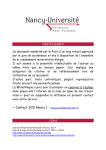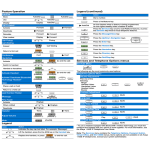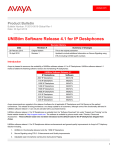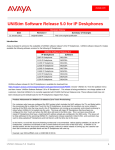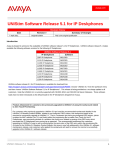Download Avaya 1165E Getting Started Manual
Transcript
Avaya 1165E IP Deskphone features • • • • • • • • • • • • • • • • Eight programmable self-labelled line feature keys* Four context-sensitive soft keys Stunning high resolution color display High-quality Handsfree Speakerphone Volume up/down and Mute keys control the ringer, handsfree, handset and headset volume Six specialized feature keys Six call-handling keys: Mute, Handsfree, Goodbye, Expand, Headset, Hold Two Gigabit Ethernet ports for LAN and PC connections Integrated headset support for wired and wireless options including USB and Bluetooth Wireless Technology USB port for connecting mouse, keyboard, or headset and other devices Supports new wideband audio for handset, headset, and speaker phone* Supports the Graphical External Application Server (GXAS) protocol Supports the Avaya 1100 Series Expansion Module to add keys IEEE 802.3af Class2 PoE and local AC power options Hearing aid compatibility Automatic network configuration Regulatory Information Avaya 1165E IP Deskphone Emissions Statement This device complies with Part 15 of the FCC Rules. Operation is subject to the following two conditions: (1) this device may not cause harmful interference, and (2) this device must accept any interference received, including interference that may cause undesired operation. Note: This equipment has been tested and found to comply with the limits for a Class B digital device, pursuant to Part 15 of the FCC Rules. These limits are designed to provide reasonable protection against harmful interference in a residential installation. This equipment generates, uses and can radiate radio frequency energy, and if not installed and used in accordance with the instructions, may cause harmful interence to radio communications. However, there is no guarantee that interference will not occur in a particular installation. If this equipment does cause harmful interference to radio or television reception, which can be determined by turning the equipment off and on, the user is encouraged to try to correct the interference by one or more of the following measures: reorient or relocate the receiving antenna, increase the separation between the equipment and receiver, connect the equipment into an outlet on a circuit different from that to which the receiver is connected, or consult the dealer or an experienced radio or TV technician for help. The user should not make changes or modifications not expressly approved by Avaya. Any such changes could void the user’s authority to operate the equipment. This Class B digital apparatus complies with Canadian ICES-003. Cet appareil numérique de la classe B est conforme à la norme NMB-003 du Canada. This device complies with the essential requirements and other relevant provisions of R&TTE directive 1999/5/EC. A copy of the Declaration may be obtained from Avaya. Use only with Avaya-approved Limited Power Source (output rated 48 V DC, 520mA.) OR standard Power over Ethernet IEEE 802.3af. Warning: The earpiece/mouthpiece region on the handset can attract and retain small objects. Privacy of communications may not be ensured when using this telephone. To prevent radio interference to the licensed service, this device must be operated indoors only and should be kept away from windows to provide maximum shielding. IMPORTANT NOTE: FCC Radiation Exposure Statement: This equipment complies with FCC radiation exposure limits set forth for an uncontrolled environment. This equipment should be installed and operated with minimum distance of 20cm between it and your body. Accessory Expansion Module port PC Ethernet port LAN Ethernet port Tilt lever **Note: If supported by your server, the Feature Status Lamp provides a user-defined alert. Contact your system administrator to find out if this feature is available to you. Link lamp USB Connector AC Adapter jack Headset jack Handset jack *Note: Support for this feature is dependent on Avaya Communication System support. Date: November 2010 Document Release: Standard 03.01 Document Number: NN43101-300 Copyright © 2010 Avaya Inc. All rights reserved. The Bluetooth word mark and logos are owned by the Bluetooth SIG, Inc. and any use of such marks by Avaya is under license. Other trademarks and trade names are those of their respective owners. Avaya 1165E IP Deskphone Getting Started Avaya 1165E IP Deskphone installation Avaya 1165E IP Deskphone installation Avaya 1165E IP Deskphone controls Caution: Your Avaya 1165E IP Deskphone is shipped with the base locked in position. To avoid damaging your IP Deskphone, pull up on the wall-mount lever, located just under the Handsfree key, to release the base. Gently pull the base away from the IP Deskphone. Ethernet cable to your IP Deskphone using the RJ-45 connector marked with the symbol (, and thread it through the channel marked with the symbol (. Connect the other end to the LAN connector on the back of your PC. holes by pressing the bottom of the stand cover firmly against the wall in the location where you wish to install the IP Deskphone. Four small pins on the bottom of the stand cover make marks on the wall. Use the marks as a guideline for installing the wall-mount screws (not provided). Install the screws so that they protrude 3 mm (1/8 inch) from the wall, and then install the phone stand mounting holes over the screw heads as indicated in Method A. You may need to remove the phone from the wall to adjust the lower screws. When the lower screws are snug, install the phone on the mounting screws, and then tighten the top screws. Due to the wide variety of materials and construction techniques, the user is advised to select an appropriate fastener or anchor type for the wall. Consult your local hardware store or other expert assistance in selecting the correct fastener for your application. Method B: Attach a 15-cm (6-inch) CAT-5e cable (not provided). Position the stand over the mounting rivets, and slide the IP Deskphone down the wall so that the rivets fit into the slots on the stand, indied in Method B. Step 9: Replace the stand cover. Ensure that all cables are neatly routed and press the stand cover into place until you hear a click. Step 10: Put the IP Deskphone in the wall-mount position (optional). If you wallmounted your IP Deskphone, put it in the wall-mount position by holding the Tilt lever and pressing the phone towards the base until the IP Deskphone is parallel with the base. Release the Tilt lever and continue to push the IP Deskphone towards the base until you hear an audible click. Ensure the IP Deskphone is securely locked in position. Step 1: Remove the stand cover. Pull upward on the center catch as indicated in the following figure, and remove the stand cover. The cable routing tracks are now accessible. Step 7: Install additional cables. If applicable, plug in optional USB devices. Connect the Ethernet cable to the LAN Ethernet connection. If you are using an AC power adapter, plug the adapter into an AC outlet. Tilt Lever Button Center Catch Method B Method A Handset cord exit Avaya 1165E IP Deskphone controls: Step 2: Connect the AC power adapter (optional). Connect the adapter to the AC adapter jack in the bottom of the phone. Form a small bend in the cable, and then thread the adapter cord through the channels in the stand. Warning: Use your Avaya 1165E IP Deskphone with the approved Avaya AC adapter. Note 1: Your Avaya 1165E IP Deskphone supports both AC power and Power over Ethernet IEEE 802.3af standard power. To use local AC power, the optional AC adapter can be ordered separately. To use Power over Ethernet, the Local Area Network (LAN) must support IEEE 802.3af standard PoE. Note 2: You must use CAT-5e (or better) cables if you want to use gigabit Ethernet. Step 3: Connect the handset. Connect the end of the handset cable with the long straight Step 8: Wall-mount your IP Deskphone (optional). Your Avaya 1165E IP Deskphone can be mounted either by: (Method A) using the mounting holes on the bottom of the phone stand, or (Method B) using a traditional-style wall-mount box with RJ-45 connector and 15cm (6-inch) RJ-45 cord (not provided). section to the back of the phone, using the RJ-9 handset jack marked with the symbol +. Form a small bend in the cable, and then thread the handset cord through the channels in the stand so that it exits behind the handset on the right side, in the Handset cord exit marked with the symbol + in the stand base, as shown in the preceding figure. Connect the handset to the cable. Step 4: Install the headset (optional). If you are installing a headset, plug the connector into the RJ-9 headset jack marked with the symbol ) on the back of the phone, and thread the headset cord along with the handset cord through the channels in the stand, so that the headset cord exits the channel marked with the symbol ). To connect USB or Bluetooth wireless technology headsets, refer to the headset information at www.avaya.com/support. Step 5: Install the Ethernet cable. Connect one end of the supplied Ethernet cable to the back of your IP Deskphone using the RJ-45 connector marked with the symbol %, and thread the network cable through the channel marked with the symbol %. Step 6: Install the Ethernet cable connecting the PC to the phone (optional). If you are connecting your PC Ethernet through the IP Deskphone, connect one end of the PC Tilt lever Wall-mount lever Complete steps 1-7, as needed, before you wall-mount your phone: Method A: Using the stand cover (the part you removed in Step 1), mark the wall-mount Controlling volume Use the volume control to adjust the sound level of each of the handset, headset, and speakerphone. Answering a call Ringing calls can be answered by lifting the handset, or pressing Handsfree or Headset keys. Making a call with the handset To make a call using the primary line, lift the handset and enter the telephone number on the dialpad. If your IP Deskphone is programmed with several line keys, press a line key to select a line before calling. When your call is complete, press the Goodbye key or return the handset to the cradle. Making a call with the headset or using Handsfree Press the Headset or Handsfree key. Enter the telephone number. When your call is complete, press the Goodbye key. Using Hold and Mute While on a call, press the Hold key to place your caller on hold. Press the line key to retrieve your call. The icons next to the line keys indicate held lines, while the Mute LED lights when Mute is active. Press the Mute key to mute your handset, headset, or speaker, allowing you to speak privately. Press the Mute key again to speak with your caller. Display settings To adjust the display settings, press the Services key twice quickly to open the Local Menu. For more information on Avaya 1165E IP Deskphone features and settings, consult the Avaya 1165E IP Deskphone User Guide specific to the Avaya Communication Server.





